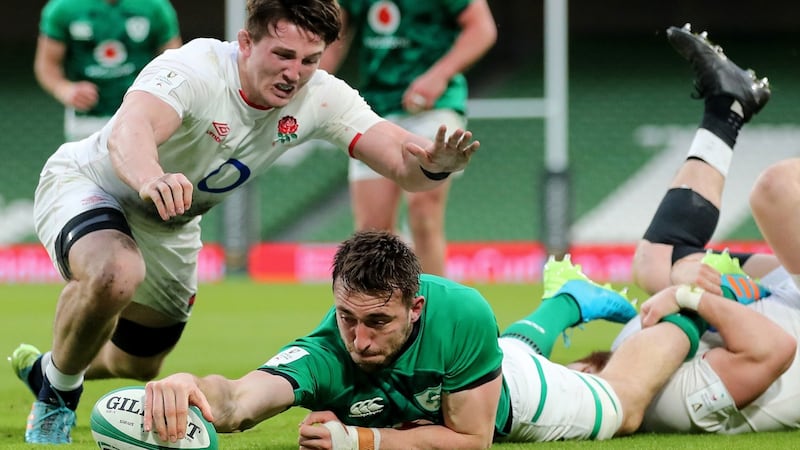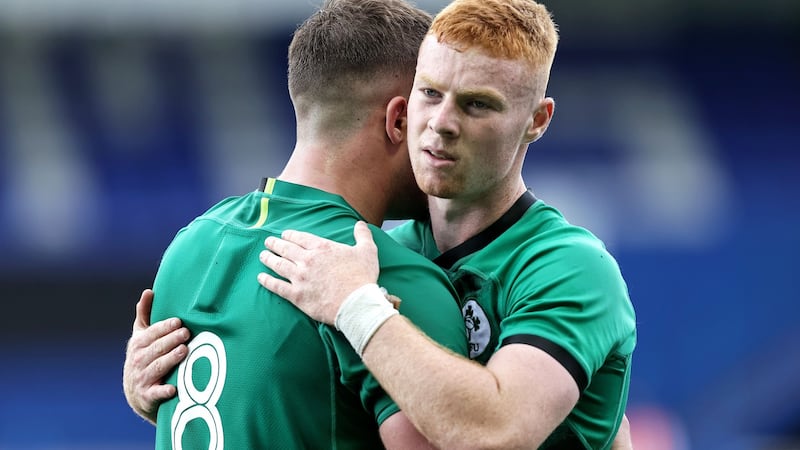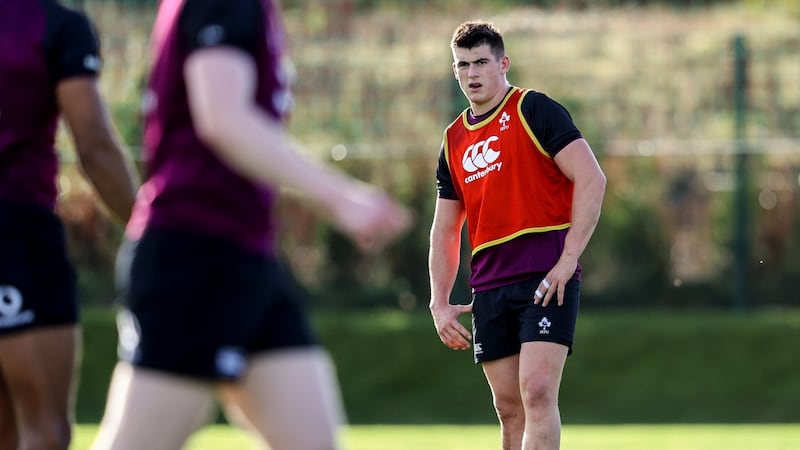This weekend marks the two-year anniversary of both the last World Cup final and the next one, so we're at the midway point in a four-year cycle under Andy Farrell. Except, of course, not remotely like we've ever known it.
At this juncture four years ago, Joe Schmidt had presided over 20 games, winning 12, drawing one and losing seven, but more pertinently had taken an Irish squad on three-Test tours to South Africa and also, with the World Cup firmly in his sights, the USA and Japan.
Identical to Farrell's tenure, the second Six Nations campaign in the latter Schmidt cycle had been redeemed by a last-day win over England at home in 2017 which also secured a second consecutive third-place finish.
The key difference is that not only have Ireland had less matches at this point under Farrell, winning 11 and losing five of 16, but they missed out on a tour to Australia, a November series with games against South Africa, Australia and Japan, as well as a three-Test summer series in Fiji.
A hybrid Autumn Nations Cup and hastily arranged summer Tests at home to Japan and the USA are all well and good, and every team has had less exposure to what used to pass for normality. But this Irish team hasn’t ‘toured’ or faced a Rugby Championship side since the World Cup. It has been operating in a bubble in more ways than one.
To put this in context, of the 38-man squad which assembled in Carton House at the beginning of the week, 16 of them have never faced New Zealand, South Africa, Australia or Argentina.
Evidence of progress has thus been restricted and sketchy.
Farrell had both the good fortune and misfortune to succeed Schmidt. Under Schmidt, Ireland augmented two earlier Six Nations titles with a Grand Slam in the third year of the last World Cup cycle, beat the All Blacks a second time and secured a come-from-behind series win in Australia.
His legacy went beyond that, for under Schmidt both Leinster and then Ireland became routinely comfortable and efficient with being favourites. It wasn’t always thus. Far from it.
But the net effect has been that whenever Ireland beat Wales, Scotland or Italy, the reaction has been ho-hum, and in defeat, it's been close to a calamity. For Farrell's tenure to have lift-off, it needed a bigger scalp, and the only two on offer thus far have been England and France.
When losing twice in Twickenham, in the last pre-pandemic days of the 2020 Six Nations and in the Autumn Nations Cup, Ireland were a distant second, which merely reopened the scars from the damaging 2019 Six Nations opening defeat and pre-World Cup Twickenham thrashing.
With an unlikely tilt at the title Ireland played some good rugby in Paris in October last year before losing. They were actually more flattered by the 15-13 scoreline at an empty Aviva last February against France, albeit they lost James Ryan, Conor Murray and Johnny Sexton on the eve of the match, in addition to Peter O'Mahony's suspension.
At that point, the midterm report might have been heading for a ho-hum six out of 10.
Ireland had again varied the point of attack and shown more variety in a good start in Cardiff before O’Mahony’s red card unhinged them. With Ryan and Sexton back after the defeat by France, Ireland carved out six good tries in Rome but, hey, it was only Italy, while they were indebted to Sexton holding his nerve with a late penalty in Murrayfield.

Cue a six-day turnaround for the finale against England and six changes, with Dave Kilcoyne, Josh van der Flier, Jack Conan, Murray, Bundee Aki and Jacob Stockdale all starting. Alas in front of no one, Ireland pummelled England into submission to end those four scarring defeats in a row with a handsome 32-18 win.
The first try was a seriously clever strike move off a lineout, Conan’s basketball pass back infield for the onrushing Keith Earls to finish brilliantly. The second was a throwback to the best of the Schmidt era, 25 phases lasting almost three minutes and culminating in Conan’s sharp close-range finish.
After a critically defiant first quarter on the back foot, again there was more evidence of variety in attack and player empowerment, be it tip-ons and offloads, decoy screens, balls out the back and getting to the edges.
For the validity of this coaching ticket and the players, beating England in the grand manner was important.
However, Schmidt’s reign also ended in severe anti-climax. Derailed by the 2019 Six Nations, there followed the defeat by Japan and the trouncing by New Zealand in the quarter-finals. So as that team’s defence coach, Farrell was both damaged goods and a new man in charge.
But in being less prescriptive while affording the players more ownership, perhaps Farrell could yet prove the perfect antidote cum successor. He’s been a leader/driver of teams as a player and coach all his life.
He heads a settled coaching ticket, the only change in this cycle seeing Paul O’Connell co-opted as lineout/forwards coach. Despite the naysayers, it looked a masterstroke then and even more so now. The lineout has steadied, providing valuable launch pads, and the defensive lineout has caused damage, with O’Connell a natural fit alongside Farrell, both being no-frills types with a winning mentality who are prepared to take risks.
Farrell has a reputation for conservatism, yet in just 16 games he has used 58 players, of whom 22 have been new caps. Nine of the current 38-man squad have started no more than one Test. And this is Ireland, with four teams, not France or England with their vast pool of players from 14 or 13 clubs.
Rónan Kelleher, Tom O’Toole, Ryan Baird, Caelan Doris, Gavin Coombes, Nick Timoney, Craig Casey, Harry Byrne, James Hume, Robert Baloucoune and Hugo Keenan have all emerged or been invested in to varying degrees. Now Dan Sheehan and Ciarán Frawley are as well, with an encouraging crop of talent coming through, even if the reduced number of URC fixtures is unhelpful.
There’ve been tweaks too, with the World Cup perhaps in mind, be it partly by design and or accident. Andrew Porter’s reversion to loosehead had been on the Leinster/Irish agendas for a time, while Cian Healy switching to tighthead could be an unexpected bonus in covering both sides and affording Farrell the chance a World Cup squad member elsewhere.
There are caveats. This is Ireland, not New Zealand. Most obviously, there is an overt dependency on Sexton who will be, yawn, 38 at the next World Cup.
But it’s not Sexton’s fault that he’s still a world-class player at 36, nor that his game management and sheer presence remain so important to the team. Nor is it Farrell’s or Mike Catt’s fault.
Ireland have five blocks of games before the World Cup warm-up matches, with the three-Test series in New Zealand, an autumn schedule of possibly four Tests (presuming the Las Vegas game is explored again) and a second Six Nations.
That amounts to 20 games, with the added probability of a fourth match against the New Zealand Maori or a Super Rugby franchise to supplement the three Tests in New Zealand. This would maximise the value of this tour and allow Farrell to bring a bigger squad to New Zealand.

Come the World Cup warm-up games and the die will largely have been cast. Later finishes to the northern hemisphere seasons and an earlier start to France 2023 (the powers that be don’t appear to have thought this one through at all) will most likely restrict the number of warm-up games to two, or at most three.
Baloucoune, Hume, Frawley, Harry Byrne, Casey, Nathan Doak, Baird, Thomas Aherne, Coombes et al look to have genuine Test potential, but to a degree they have to force their way into the team at provincial level, in training camps and grasp whatever opportunities may arise.
The games against Argentina and Italy offer some scope for experimentation, as does that fourth game in New Zealand, the potentially revisited Las Vegas game and maybe one other in November of next year.
Perhaps if Ireland had won the rights to host the 2023 tournament then Farrell and co could treat much of the intervening time as Fabien Galthie is doing, or else a decision is taken to treat this season’s Six Nations as a roll of the dice.
Even then, none of the aforementioned young guns are going to arrive at the World Cup with 20 Test caps under their belts. It’s just not doable.
Gilt-edged opportunities for experimentation are limited. Ireland needs a strong November and the inadequate build-up compels Farrell and co to ensure that Ireland’s frontliners front up against Japan and the All Blacks.
The November series feeds into ticket sales for the three home games in the Six Nations against Wales, Italy and Scotland and, of course, history and prizemoney also demands that Ireland puts its best foot forward.
Furthermore, TV rights packages for the November window have henceforth been linked in with the Six Nations. Besides, nothing damages or generates ticket sales quite like bad or good results, Stephen Kenny’s Ireland team being a classic example.
Yet while Farrell and his assistants have cranked up the World Cup factor two years out, and this has been welcomed by Sexton, even a four-year cycle cannot be judged solely on the World Cup. Otherwise the Grand Slams of 2009 and 2018, along with the titles of 2014 and ’15 don’t count, any more so than the wins over the southern hemisphere big three.
Unless there’s a radical rethink, shipping 50-pointers against the All Blacks, or finishing in the bottom half of the Six Nations, won’t do anything for this team’s momentum or cut Farrell and co any slack.
Besides which, lest we forget, Ireland are in the same World Cup group as the reigning World champions, a dangerous Scottish side and most probably Samoa. And the prospective reward for advancing from that pool of sharks is a quarter-final against the current number one ranked side in the world and favourites, or the revitalised hosts and current second favourites.
Even from this remove, that quarter-final glass ceiling has never looked so impenetrable.
Gerry Thornley’s Possible Irish first-choice team for the 2023 World Cup
15 Hugo Keenan
14 Jordan Larmour
13 Garry Ringrose
12 Robbie Henshaw
11 Jacob Stockdale
10 Johnny Sexton
9 Conor Murray
1 Andrew Porter
2 Rónan Kelleher
3 Tadhg Furlong
4 James Ryan
5 Iain Henderson
6 Caelan Doris
7 Josh van der Flier
8 Jack Conan
Bench
16 Dan Sheehan
17 David Kilcoyne
18 Tom O'Toole
19 Ryan Baird
20 Gavin Coombes
21 Craig Casey
22 Joey Carbery
23 Simon Zebo

Five players who could break into the team
Robert Baloucoune (24, winger, 1 cap)
Followed his Senegalese father in playing football until he was 15, when persuaded by friends to take up rugby, coming through Enniskillen GS and Enniskillen RFC. Honed his game with the Irish Sevens and broke into the Ulster team, Baloucoune was in pre-2020 Six Nations camp in Portugal but was sidelined for a year with a hamstring injury. A good one-on-one defender with top end speed and a Doug Howlett-like ability to change direction at full tilt, as seen in his try on debut in July
James Hume (22, centre, 1 cap)
Hume won three successive Ulster schools senior cups with RBAI before developing at Banbridge RFC and the Irish under-20s, breaking into the Ulster team three years ago before a torn hamstring interrupted his progress. In the absence of Luke Marshall, he’s become Stuart McCloskey’s regular midfield partner with Ulster. A powerful and elegant runner, and good defender who has improved his distribution. The manner he also took to Test rugby against the USA affirms the impression that he is fairly unflappable.
Neil Doak (19, scrumhalf, uncapped)
Another off the recent production line of young Ulster backs. Doak’s dad was also an accomplished goalkicking scrumhalf and international cricketer who was unlucky not to win a cap in rugby. His renowned coaching skills have contributed to his son being a bigger, quicker and more complete ‘9’. A standout performer for the Irish under-20s along with Alex Kendellen, Doak plays with the calmness and maturity of a seasoned pro and hard to think of a more talented Irish scrumhalf at his age. Ever.
Dan Sheehan (23, hooker, uncapped)
Part of a new wave of young hookers, the Clongowes product was behind Rónan Kelleher and Diarmuid Barron in the under-20 pecking order but his AIL form for Trinity has had Tony Smeeth talking him up for years. At 6’ 3” and 110kg he’s dynamic with a passing and offloading game. Always a hooker, his darts are goo too. In just 17 games for Leinster, and five starts, he has nine tries. Leinster look sorted for a decade, and maybe Ireland too.
Gavin Coombes (23, number 8, 2 caps).
A product of Bandon GS and his home town club Skibbereen and a standout performer for the Irish under-20s in 2017, it has always seemed merely a matter of when his time came. Following in the footsteps of Anthony Foley, James Coughlan and CJ Stander, he already looks a fitting heir to the famed Munster ‘8’ throne. At 6’ 6’” he has both the ballast and try-scoring eye (19 in 41 games) of Stander and much of Foley’s distribution skills. Real competition for Conan and Doris.






















